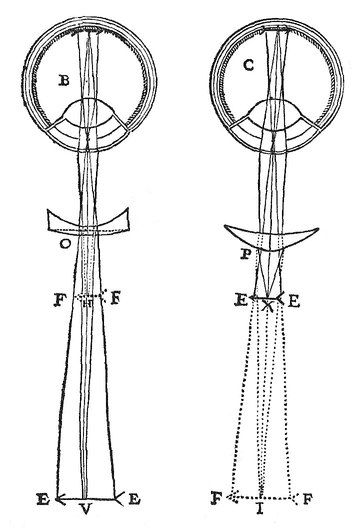Eyeglasses
Table of Contents
To remedy these defects, we should seek a piece of glass or some transparent body which have surfaces that can bend the rays which fall on it so that the light can be diverted, by crossing them, into the eye.
For, for example, the eye B or C[28] caused the rays which come from the point H or I to
assemble in the middle of its back.

and, not being able to, to also cause those of point V or X to assemble there;
If we put in front of it the glass O or P, which causes all the rays from the point V or X to enter inside just the same as if they came from the point H or I, we will compensate by this average to its defect.
There may be glasses of different shapes which can have this same effect. There are 2 conditions in choosing the best glass:
-
These shapes should be the simplest and easiest to draw and carve as possible.
-
The rays which come from other points of the object, like
EE, should enter the eye almost as if they came from as many other points, likeFF
I say here approximately, not as much as possible. This is because it would be difficult to determine by geometry, among an infinity of shapes, which can serve for this purpose.
Those which are the most suitable for it would be useless because the eye even if they do not cause all the rays which come from various points to assemble precisely
at as many other various points, they would doubtless not therefore be the most suitable for making the vision quite distinct.
It is impossible in this to choose otherwise than approximately, because the precise shape of the eye is unknown to us.
Moreover, we will always have to take care,
When we apply some body before our eyes, we should imitate nature as far as possible in all the things that we see.
In this way, we lose none of the advantages Nature has given us and gain some important ones.
The size of the images depends only on 3 things:
- The distance between the object and the bottom of the eye where they rays it sends intersect.
-
What is between this same place and the fundus of the eye
-
The refraction of these rays.
The image RST[29] would be larger than it is if the object VXY were closer to the place K where the rays VKR and YKT intersect, or rather to the area BCD which is properly the place where they begin to cross, as you will see below.

Or, if we could make the body of the eye longer, so that there would be more distance than there is.
There is from its surface BCD, which causes these rays to intersect, to the bottom RST.
If the refraction did not bend them so much inwards towards the middle S, but rather outwards.
Besides these 3 things, nothing else can make that picture bigger. Even the last is hardly considerable because one can only increase the image very little by this means.
So we see that nature has neglected it. Nature caused the rays, like VKR and YKT, to curve inwards towards S on the surfaces BCD and 123.
It made the RST image a little smaller than if it had made them curve outwards, as they are around 5 on the area 456, or she would have let them be straight.
There is also no need to consider the first of these three things when these objects are not at all accessible.
But, when they are, the more closely we look at them, the larger their images are formed in the depths of our eyes.